Living in the modern world, we take how easy it is to contact our loved ones for granted. But, in an emergency, communicating isn’t as easy as picking up your cell phone.
How can you contact your family, who may be 5 or even 50 miles away?
You’ll need to get a two-way radio unless you want to use a smoke signal on a tall hill.
There are many types of two-way radios, including some which allow you to talk to groups. Some require a license to operate.
This guide will cover information about choosing a two-way radio for emergencies and recommend reliable products.
The Overview:
A two-way radio allows you to communicate with others over a set distance. For emergency preparedness, HAM radios are the best option.
They are reliable, and even handheld options can transmit up to 50 miles. However, they do require a license and are more expensive to buy.
For transmitting around camp, during hikes, or contacting family members who might be up to 5 miles away in a suburban area, GMRS and CB radios are good options.
They are cheaper and easier to learn – but don’t be surprised if you find yourself getting pulled toward HAM radios later.
We get in-depth on the best products later, but here’s a quick look at our top picks in each category:
What is a 2-Way Radio?
A two-way radio is simply any radio which can transmit and receive voice communications. This is different from broadcast radios that transmit but don’t receive signals.
Two-way radios can be stationary, portable, or a combination of stationary and portable. Here are some examples of these.
| Type | Example |
|---|---|
| Stationary | Military bases using radios to communicate with each other. |
| Portable | Truck drivers using radios to communicate traffic information. |
| Combination | Base station communicating with team members on the move, such as taxi dispatchers, airline controllers, or police stations. |
Want Kind Do You Need?
Hopefully, you’ve already made an emergency plan for your family. This should include a communication plan – such as where you will meet up if separated and how you will get in touch.
Once you’ve made this emergency plan, you can figure out which kind of two-way radio to get.
You’ll probably want portable radios. Each member can keep a radio in their car, work, or school locker. It’s also nice to have a radio at your home base.
Difference between 2-Way Radios and Walkie Talkies
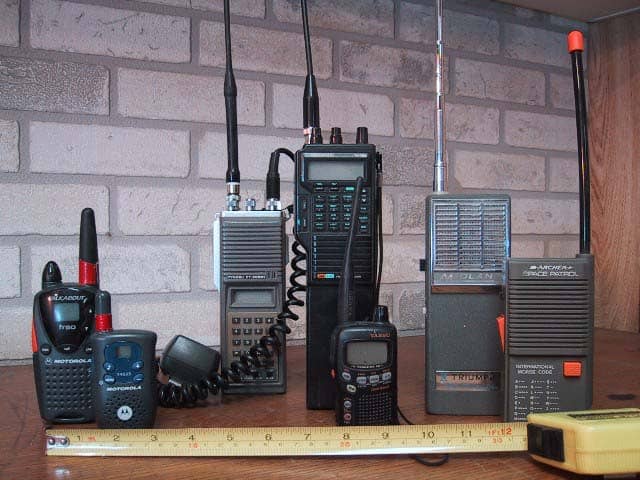
There is a lot of confusion about the difference between 2-way radios and walkie-talkies. The two terms are often incorrectly used interchangeably.
To make matters worse, we usually associate the term “walkie-talkie” with children’s toys, so people will think that a walkie-talkie must be inferior to a 2-way radio.
A walkie-talkie is simply any portable 2-way radio.
They were first used in WWII but later became available as cheap kid’s toys (which is why the term has picked up a bad connotation). A walkie-talkie doesn’t have to be bad quality. Many walkie-talkies are capable of transmitting signals long distances.
A walkie-talkie is a 2-way radio, but not all 2-way radios are walkie-talkies (think squares and rectangles). This is because some 2-way radios are stationary. If either end of the 2-way radio has a “base,” it isn’t a walkie-talkie.
Note: Ham radios cannot talk to a CB radio
Two-Way Radio Terminology
There is a lot that goes into learning two-way radios. If you get your HAM license, you’ll have to learn all this, operating practices, FCC rules, and much more.
For the sake of choosing and buying a two-way radio for emergencies, you’ll at least need to know these terms below.
Wattage:
Wattage is a measure of how much power a two-way radio uses. The higher the wattage, the better it will be able to transmit. This is important if you want to send messages over a long distance – especially if obstacles like forests or mountains may be in the way.
The downside of high wattage is that it will blow through batteries quickly. Good two-way radios will let you select from a wattage range. This allows you to conserve the battery when you don’t need high wattage.
Range:
Range is how far a two-way radio can transmit. It is common for two-way radios to overstate their range. Many reviewers find that a 25-mile range radio, for example, will only transmit 3 miles.
Bear in mind that range is given for ideal circumstances.
Obstacles like trees, mountains, tall buildings, or bad weather can significantly hinder range. This has to do with the fact that two-way radio waves usually are between 150-900MHz frequency. These waves can only travel in straight lines.
On certain types of two-way radios, the range can be increased using:
Antennas
Repeaters – a device that receives a signal and repeats it at a higher power
Better batteries
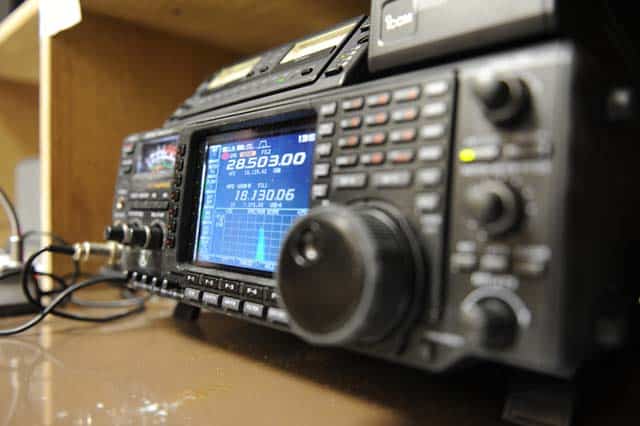
Frequency:
Two-way radios use either VHF (Very High Frequency) or UHF (Ultra High Frequency). Of the two, UHF tends to be stronger as it can better transmit through obstacles.
Note that VHF and UHF are not compatible with each other. If you already have a VHF radio and want to add another to communicate with it, you won’t be able to use a UHF.
Channels:
Channels are a specific frequency over which you communicate. You can set a channel for each group. For example, a concert venue might have one channel for security and another for the lighting crew.
Most two-way radios have at least 22 channels. Some models offer many more channels. However, you may not be able to communicate over all the channels. For example, 10 of the channels might be weather alerts.
Because there is a limited number of channels, there is a possibility that a third party could hear your communications – especially if you are in a crowded area where there might be many people using radios within your range.
It also means you could hear other people (which makes a lot of noise!) To squelch this undesired noise, you can use “privacy codes.” These use a filtering system that blocks any communications which aren’t set to the same privacy code.
Types of 2-Way Radios – Quick Overview
There are many types available. The core differences are their allowed watts, range, and number of channels. There are also legal restrictions for using some types of 2-way radios.
Below is a quick summary of the pros and cons of each type, and below we get into more detail about the best two-way radios for your situation.
Ham Radio Key Facts
Pros
- Very long range
- Many frequencies
- Can communicate directly with local emergency responders
- Up to 1500 watts legally
- Can use extenders and amplifiers
- Higher quality communications
- Community of HAM operators
- Handheld range up to 20miles
- Mobile and base ranges over 50 miles
Cons
- Requires license
- More expensive
- Higher learning curve
- Equipment not as readily available
CB Radio Key Facts
Pros
- No license required
- Many channels
- Up to a 50-mile range
Cons
- Channels often busy and noisy
- Only 3-5mile range handheld
- Max of 4 watts (AM) or 12 watts (PEP SSB)
FRS Key Facts
Pros
- No license required
- Low learning curve
Cons
- Very short range
- Often low-quality products
GMRS Key Facts
Pros
- One license covers entire family
- No test required to get license
- Up to 25-mile range
- Good sound quality
- Not a lot of noise
- Can communicate with FRS radios on some channels
Cons
- Requires license
- Not as many people using as HAM
MURS Key Facts
Pros
- No license required
- Channels not very busy
Cons
- Only up to 3-mile range
- Not very popular
Detailed Overview
Ham Radio
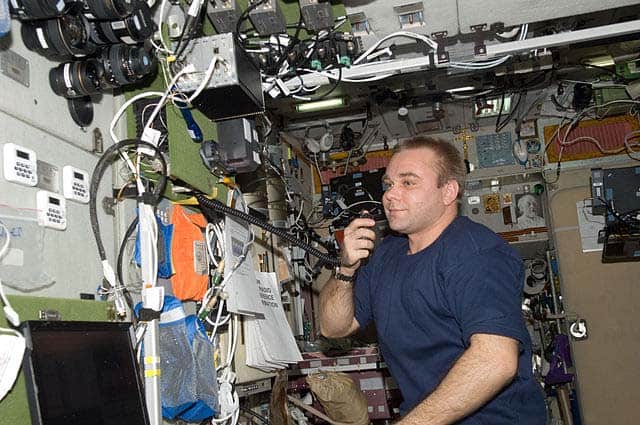
Amateur Radio Service, more commonly referred to as Ham radio, allows users to talk to other operators across the globe. The “amateur” part doesn’t mean novice. Instead, amateur means “non-commercial” in this case.
Because of its long range and the skills required to operate a ham radio without causing interference, the FCC requires Ham radio operators to be licensed. Read more about Ham radio range.
Recommended Reading: Ham Radios: The Best Emergency Communications System
Note that it isn’t the ham radio which gets licensed. It is the operator who must be licensed. For online Ham classes see HamRadioPrep they offer a money back guarantee if you don’t pass the exam. Use code PRIMAL for 20% Off.
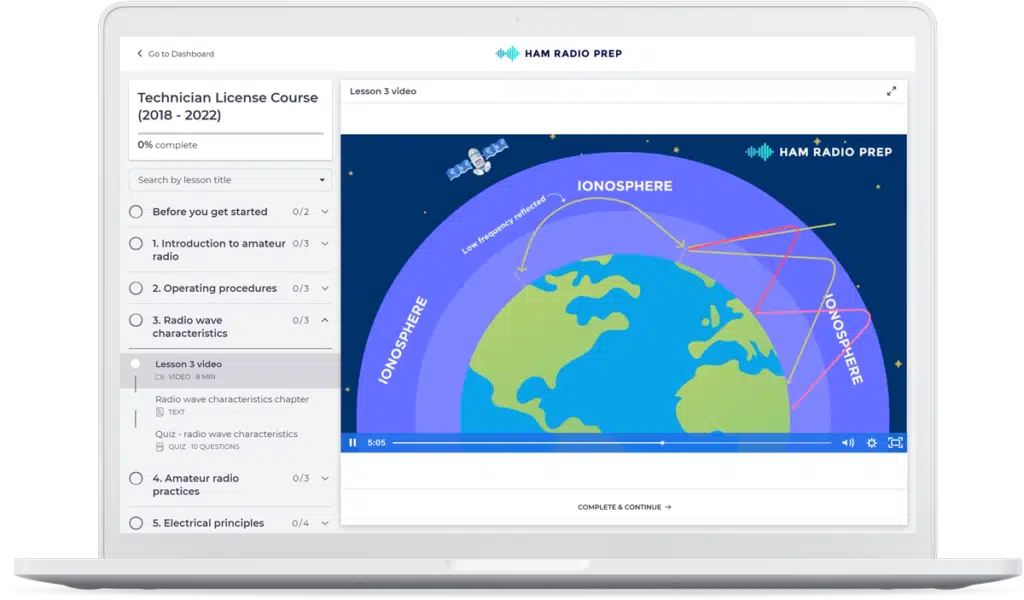 Ham Radio Online License Classes
Ham Radio Online License Classes
The Ham Radio Prep program makes it fast, easy and fun to get your license in just a few hours of study time. They even offer a money-back guarantee if you don't pass your exam on your first try.
Use code PRIMAL for 20% OFF!
ARRL.org states 600,000 ham radio amateurs are in the USA and over 2 million worldwide.
Many ham radio operators are hobbyists who enjoy the technology and communicating. Ham radio can be interfaced with a computer or tablet to send data, texts, images, or Morse code. There are ham radio contests where the object is to see how many hams in far-away locations can be contacted. You can even call an astronaut using ham radio. Cool!
When an emergency occurs, “hammers” are often the first to respond. This was the case with Hurricane Harvey and Hurricane Maria.
Ham radios can be incredibly powerful, but the typical handheld ham radio is about 5 watts or less. Mobile ham radios are usually around 10 to 100 watts, and ham base stations typically have 100 to 200 watts.
Amplifiers can be used to increase the power to 1000+ watts. Antennas can be installed on rooftops or towers to increase range.
Note that there are different ham radio license types, and some limit how many watts you can use. Here is a cheat sheet of allowed frequencies and modes.
Overview:
- Max Power: 5 watts (handheld); 50 watts (mobile); 1500 watts (base)
- Band: HF, UHF, VHR
- Assigned Channels? No
- Range: 1-20 miles (handheld); 5-1200 miles (mobile); 50-2500 miles (base)
- License required? Yes
- Best HAM Radio for preppers
CB Radio
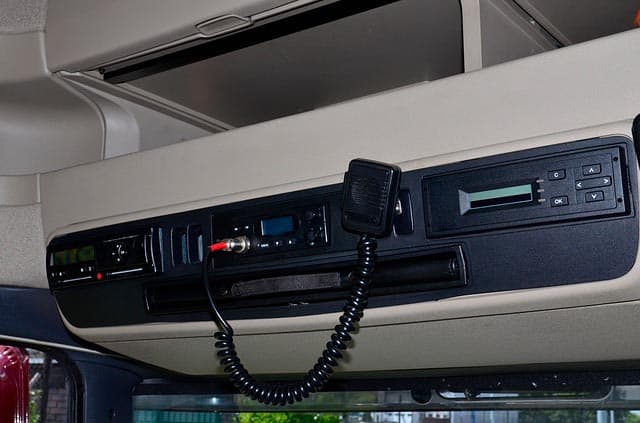
CB stands for Citizens Band Radio Service. These are very powerful 2-way radios commonly used by truckers and operate on a 27 MHz HF (shortwave) band.
CB is the “wild west of radio services.”
There are almost no legal requirements for operating a CB radio. The FCC rules (95.403) only state that foreign governments cannot use CB radio, and people with an FCC cease and desist order cannot operate CB radio. You are not allowed to have overseas communications with CB radio.
There are 40 channels on CB radio. Each channel can be used in AM or single sideband modes (SSB). The SSB mode is further divided into upper sideband mode (USB) and lower sideband mode (LSB). This gives users even more channels to choose from.
Note that SSB CB radios usually cost more than AM CB radios. However, SSB CB radios have a much longer range and are more reliable in bad weather conditions.
Overview
- Max Power: 12 watts in PEP SSB; 4W watts in AM
- Band: AM and SBB
- Assigned Channels? Yes
- Range: 3-5 miles (handheld); 7-10 miles (mobile); 10-50 miles (base)
- License required? No
FRS Radio
Family Radio Service (FRS) is becoming increasingly popular because it doesn’t require a license and is easy to use.
There are 14 FRS channels, of which 7 are dedicated to FRS, and the other 7 are shared with GMRS.
Many walkie-talkies are combos of FRS/GMRS. The range of FRS radios is limited, so these would be good for communicating with people around a base camp or in the wilderness.
Overview
- Max Power: 5 watts
- Band: UHF
- Assigned Channels? Yes
- Range: 1-2 miles (handheld)
- License required? No
GMRS Radio
General Mobile Radio Service (GMRS) is a 2-way radio for short-distance communications. However, you can use repeaters with GMRS to get much longer ranges.
The great thing about GMRS is that it is FM. By comparison, CB operates on the 11-meter (27mhz) HF band in AM. Without getting into technical details, this means that GMRS is much quieter and has better sound quality.
There are a total of 15 channels, of which FRS shares 7. A license is required for GMRS, but only one license is needed for the entire family.
Overview
- Max Power: 5o watts
- Band: UHF
- Assigned Channels? Yes
- Range: 5-25 miles (mobile)
- License required? Yes
MURS Radio
Multi-Use Radio Service (MURS) was created in 2000 and doesn’t require a license. It has a max power of 2 watts, which is higher than an FRS.
However, its popularity is stifled because there aren’t many MURS radios to choose from. Because MURS isn’t as popular, channels won’t be as busy.
Overview
- Max Power: 2 watts
- Band: VFH
- Assigned Channels? Yes
- Range: 2-3 miles (handheld)
- License required? No
Which Two-Way Radio System Is Best?
When choosing a two-way radio for emergency communication, these are the things you need to consider:
- Signal range
- How much time you are willing to invest in learning the system
- How busy channels are
- Whether you can listen to emergency broadcasts and NOAA alerts
- Communication with local emergency responders
- Cost of license and radios
Considering these considerations, the only types of two-way radios worth considering are HAM, GMRS, or CB.
Choose HAM if:
You may need to communicate over a distance of 50+ miles
Mountains, forests, or other obstacles might block signals
You want to be able to communicate with emergency responders
You like the idea of being involved in a community of amateur radio enthusiasts
You’re willing to invest time to learn HAM and get licensed
Choose GMRS if:
You are primarily concerned with communicating with your family, not emergency responders
A range of up to 25 miles is adequate
You don’t want to pay for a license for each user
Choose CB if:
You don’t want to pay for a license
You don’t mind listening to static and profanity
You want a cheap and easy solution until you can upgrade to GMRS or HAM
Best HAM Radios
If you are serious about two-way radios and want something reliable, go with a HAM radio. You can buy the radio but remember you’ll need a license to operate it.
 Ham Radio Online License Classes
Ham Radio Online License Classes
The Ham Radio Prep program makes it fast, easy and fun to get your license in just a few hours of study time. They even offer a money-back guarantee if you don't pass your exam on your first try.
Use code PRIMAL for 20% OFF!
BaoFeng BF-F8HP
Why get it?
Excellent battery life, durability, and hands-free feature make it great for Bug Out Bags.
Features:
- 20-hour battery life
- Built-in flashlight
- Lightweight
- 1w/4w/8w power settings
- Dual watch receiver
- Supports CTCSS, DCS, and DTMR
- Handless operation with VOX
- 65-108MHz range
- Very affordable price
BTECH Mobile UV-50X2
Why get it?
As far as car HAM radios go, this has an impressive range of features yet is still affordable.
Features
- Great price
- 136-174MHz on VHF and 400-520MHz on UHF band
- High\low power settings 10 and 50 watts
- Dual-band
- Multi-function scanning
- Variable frequency scanning
- Privacy mode
Best GMRS Radio
You don’t have to take a test to get a GMRS license; a single license will cover your entire family. This means you can get started almost immediately.
GMRS radios can get great range and have many built-in emergency features like NOAA alerts.
The model below is a good option.
Midland GXT1000VPR
Why get it?
For its price group, the GXT1000VPR works surprisingly well. It’s great for newbies to two-way radios who want something to serve during a disaster but doesn’t require a huge investment.
Features
- 36-mile range
- 50 channels
- 10 weather channels
- Waterproof
- Dual watch monitor
- Auto squelch
- 142 privacy codes
- SOS siren
- NOAA alert enabled
- Good battery life
- Affordable
Best CB Radios
CB radios aren’t recommended for emergencies. But a CB radio is the best alternative if you don’t want to get a GMRS or HAM license.
The models below have some decent features for emergency preparedness. You can also use the CB for monitoring traffic – so long as you don’t mind the noise and profanity!
Uniden Bearcat 880
Why get it?
It does a great job of canceling the noise you usually get on CB. It is also straightforward to use, so an excellent option for beginners.
Features
- 40 channels
- 10 NOAA weather channels
- 7 color display
- Handheld or mountable
- 6-pin noise canceling
- Squelch control
- Instant Channel 9
- Analog S/RF meter
- User-friendly design
- External speaker capability
- Affordable
- Compatible with wireless mics
President McKinley USA
Why get it?
This is the crème de la crème of CB radios. It receives and transmits over long distances and has cool features like self-calibration of SWR and overrides.
President also makes some other high-tech CB radios, but this is an overall favorite.
Features
- 40 channels
- 10 NOAA weather channels
- 12/24V
- Alerts plus overrides
- SWR self-calibration and testing
- Tone control
- Roger beep and optional keep beep
- Switchable talkback
- Noise blanker
- Hands-free operation with VOX
- 3-color display plus dimmer
- In-dash mounting
- Plus tons of other features
Do you have a two-way radio for emergency communication? Which type did you choose and why? Let us know in the comments.
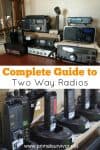







I just started getting into this and bought a baofeng uv9g. I think its a good radio and it has the IP67 ratings which is what I really wanted it to have. I just wish it had the ability to scan on the airband. i might get another one just for that.
I have radios in all my ag equipment. How do I know what Im kind of radio im using.
Hi.
Im from the Philippines.
Got 2 UV-82 and a UV6R.
All for emergency use.
Just in case.
Id love to extend range of these units.
You left out mobile and confused it with portable.
Stationary (Desktop) AKA Base units.
Mobile. Mountable in vehicles.
Portable. Hand held.
Man pack. Usually a larger radio with better power output then a hand held (HT portable.)
Combination. (like a mobile radio and battery in a backpack for better comms with the above.
Thanks for the clarifications.
I want to get information about two-way radio and ham radio I can you for my LDS emergency communications which one I used us
Look up your local LDS ERC. Google that. Also check LDS tools to see if your ward has some one set apart as the ERC operator. But for an individual radio? I started with just a hand held HT, then a mobile unit then bought a desk top unit. The desk top is a FT-897D [discontinued now]. The FT-857 is still made. Exact same insides/menu. Just a different external look and power utilization. Also your local bishops store house might have a radio already hooked up. Maybe ask around and see if you could get a tour or talk to some local club members.
You left out the marine radios.
Due to changes made in 2017, all 22 channels are now shared between FRS and GMRS. GMRS has an additional 8 frequencies for repeaters. GMRS allows for external antennas, use of repeaters, and more power (except on channels 8-14, where both services are limited to 0.5 watts).
Barry Schaumburg Maximum Power for GMRS is 50W not 5W
Typo! has been corrected. Thanks for the heads up!
Max power for gmrs is 50 watts yes, but on the shared interstitial frequencies shared with FRS the max is 5 watts.
Maximum power for GMRS is 50W not 5W.
What are your thoughts and knowledge about the Tera TR 505 two way radios made by Better Safe Radio.
Inaccurate description and purpose of privacy codes. You say “there is a possibility that a third party could hear your communications. To prevent this, you can use ‘privacy codes.’”
This is not accurate. It should read
“There is a possibility that YOU could hear a third party. To prevent this…”
When most FRS/GRMS radios are set to NOT have a privacy codes, they can now hear ALL transmissions regardless of privacy code.
HI Squirrel, thanks for picking up on that – we have amended the incorrect info.
What MURS portable radios would you recommend?
We don’t really recommend MURS for preppers at the moment for the reasons given above, so no products to recommend.
A friend is not covered by your license. Only immediate family members are covered. Your friend could use an FRS radio which shares some channels or frequencies with GMRS so that you could talk to him, but his radio would be limited to two watts so you might not be able to to pickup his signal if he’s very far away, but he could hear yours because you can use either 5 watts or 50 watts according to the channel being used on GMRS… If you are also speaking to him in FRS channels I think one can only use 2 watts, but I’m not sure . There are shared channels with GMRS and FRS. So you could talk to him if he has an FRS or family radio service walkie talkie. No license required for FRS radios. Hope this all made sense. Just encourage him to get the GMRS license. It’s only 35 dollars and his immediate family also has privileges with his license..
a high hill…..with smoke signals …works best
I have a GMRS license. If I use a walkie talkie an the GMRS band, does the other person on the other end need to have a license to transmit back to me?
If I am on my farm and go out with a friend, I may communicate with him and he will respond. I am licensed. Does my license apply to his use of the system?
I believe your licence covers family members not sure about friends. You would need to verify this to your own satisfaction. Some good info here – https://quality2wayradios.com/store/GMRS-FCC-License
Mac,
There is no legal radio that can do that. CB is about useless anymore due to wave reflection from sky layers. Truckers rarely use it. Get a Ham technician license and use FM 2 meter repeaters. Many have internet connections that can be used to talk around the world.
I’m looking for a good hand held , usb rechargeable. Or regular batteries. Will pick up all bands and weather …will transmit on ham or cb bands and water proof
I’d recommend the Yaesu VX-6R, since this is the radio I purchased for similar reasons. It can hear almost anything (though it isn’t capable of SSB). It’s waterproof (submersible) and can transmit on three ham bands. It can receive CB, but it cannot transmit on those frequencies. If you want a handheld which can also be used to listen to SSB, take a look at the (significantly more expensive) Kenwood TH-D74A.
Thanks Nathan both can be found on Amazon and are well reviewed:
Edit the Kenwood is out of stock, may be discontinued.
Yaesu VX-6R
This was very helpful. I’m looking for a two way radio to reach Family roughly 5-6 miles away in a suburban area in the event of an emergency. From what I read here, a CB or GMRS would be idea. Of the two, is one more recommended?
Hi Ashley – this article has been updated, we now list the pros and cons of each choice to help you make the right decision.
UHF 20 CHANNEL TWO WAY HAND HELD
I need to know, if I am 50 miles away from my family and something happens that all phones no longer work,what cb or ham radio can I depend on to make sure I can contact my family.
Hi Louie we don’t have any particular products to recommend at the moment but you can check this post out for more background info – https://www.primalsurvivor.net/ham-radios-emergency-communications/
Just one missed thing, you missed “FM” for ham
Very well written with ample information. Good site to get a quick run down before buying.
Thanks, VRA